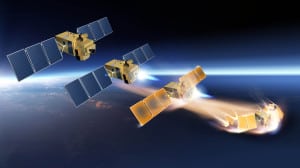Latest News
[Via Satellite 05-19-2016] As defunct and uncontrolled spacecraft continue to present a threat to in-service satellites Airbus Defense & Space, alongside 10 European partners, will lead a $3.1 million project to remove space debris from orbit. The Technology for Self-Removal of Spacecraft (TeSeR) program, led by Airbus and with funding from the European Commission, will carry out a two-year project for the initial research for the development of a prototype of a “cost-efficient but highly-reliable” removal module. The planned module aims to ensure the disposal of future spacecraft at the end of their nominal operational lifetime and could also function as a removal back-up in the event of loss of control of the spacecraft.
“The TeSeR module will have two interfaces: one link to the spacecraft and one connection with the removal subsystem. Depending on the orbit, mass, shape, and structure of a spacecraft, a suitable removal technology will be selected,” Airbus Defense & Space TeSeR Project Manager Phillip Vogt told Via Satellite.
The TeSeR project will investigate three different removal technologies: solid propulsion, drag augmentation systems and electrodynamic tether. As each of these removal technologies has its specific advantages, the TeSeR project will analyze how and when each can be used.
“The versatile TeSeR module does not only act as the ‘smart interface’ between the spacecraft and the removal subsystem of choice, but it is also equipped with the appropriate level of autonomy. A minimum level of autonomy — e.g. regarding power supply and communications — is necessary to ensure the removal in cases where a spacecraft suffers a complete in-service failure,” said Vogt.
The program and funding will provide for the development of an on-ground prototype that will test and validate the functionalities of the module and the associated removal technologies.
Ultimately, the two-year project aims to protect in-orbit satellites as the growing space debris population jeopardizes the use of space. The amount of debris in orbit — the majority of which is human-generated as a result of launching and operating satellites — has reached an estimated 500,000 pieces, Brian Weeden, technical advisor at the Secure World Foundation, told Via Satellite in an earlier interview.
“Many spacecraft are not being removed after they finish operating. They may not have the necessary removal technology on board or suffer from technical failures and, thus, turn into space junk,” said Vogt, who points to the Iridium 33 – Kosmos 2251collision that occurred on Feb. 10, 2009 over Northern Siberia as an example of the dangers that dead satellites left in orbit pose to healthy spacecraft. In this incident, a defunct and an operating satellite collided and created hundreds of new pieces of debris. As a result, many other spacecraft had to fly avoidance maneuvers, which consume fuel and reduce a satellite’s lifetime.
Today, in Low Earth Orbit (LEO), one of the most densely populated orbit regions, satellites receive dozens of conjunction warnings every year. Although only a few warnings will lead operators to initiate actual avoidance maneuvers, these still serve to lower the satellite’s lifetime. Furthermore, tracking the orbits of space debris is currently limited to larger pieces, which represent only a small fraction of the entire debris population. As orbit determination for space debris is subject to inaccuracies, collision projections are a matter of probability calculus, according to Vogt.
“In order to mitigate the space debris problem, all future spacecraft should be removed at the end of their mission. Currently, the engineering of post-mission disposal systems is complex and costly. Conventional solutions are usually tailor-made for a specific spacecraft,” said Vogt.
In contrast, Vogt claims that TeSeR will offer a modular, standardized and reliable solution at lower cost for both government and commercial operators. The program, which kicked off in February, aims to have an on-ground prototype ready by 2018. To date, the project has begun almost all technical design work concerning the module and the removal subsystems. The next milestone for the technology will be the mission requirements review, which will take place this summer.
Within the first year of the project, Vogt said the program participants will look to complete the mission analysis, re-entry analysis and passive attitude and orbit control concepts. He is hoping to pass the mission requirements review within less than a year from the project’s start as well as conceptualize and design the specifications for the removal subsystems.
To date, Vogt has cited a few challenges that still exist in designing and proving the system.
“One challenge concerns the definition of interfaces between the module and the spacecraft as well as the module and the different removal subsystems. Another challenge is to find the appropriate level of autonomy for the module. Here we have to strike a balance between autonomy and a simple design suited to industrialization,” he said.
While the business success of the TeSeR solution depends on several factors, including the technology’s reliability and cost as well as operators and manufacturers ability to accept the technology, Vogt believes the companies involved in the project will be able to make the business case for the debris-removal module.
“Reducing the creation of new debris by removing defunct and uncontrolled spacecraft is a major step toward a sustainable space environment for future generations,” Vogt said.
Get the latest Via Satellite news!
Subscribe Now